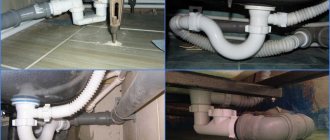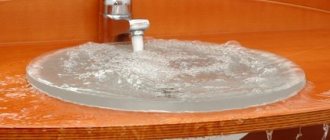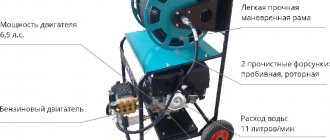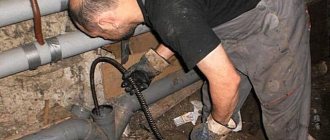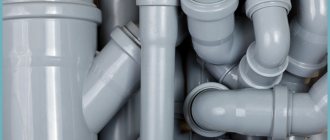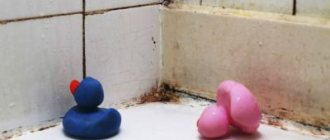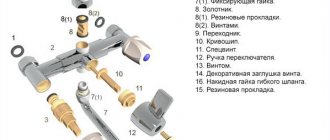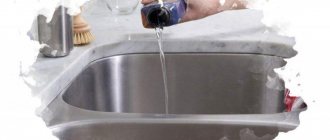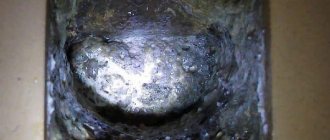It is difficult for an untrained person to remove blockages. The process takes a lot of time, and does not always end with a solution to the problem.
Having studied in advance all possible ways to remove blockages in the bathroom, you can achieve the desired result as quickly as possible and without much effort.
We’ll tell you in this article how to remove a blockage in the bathroom using available means, chemical compounds and more.
Causes
The main reason why the problem of blockages in the bathroom arises is the lack of regular maintenance of plumbing products . Dirt, grease, hair and other small debris, after each use of the bathtub, settles on the walls of the drain hole, the surfaces of the siphon and pipes.
Over time, the lack of regular cleaning leads to the fact that dirt particles compact and form a plug that blocks the normal flow of water.
Also, the problem with frequent blockages in the bathroom may be associated with errors made during the installation of plumbing products (insufficient pipe diameter, large number of joints, incorrect slope of the drain pipe).
Depending on what caused the blockage, one or another method of eliminating the problem is selected.
Finding out the cause of blockages
Any blockage is formed as a result of violation of the established rules for sewerage operation. In multi-storey buildings, the blockage can be local - within one apartment, or general, when the common sewer line is clogged.
The cause of a clogged pipe in the bathroom may be:
- settling on the walls of mud lumps formed from particles of small debris and hair;
- layering of fatty deposits on the pipes;
- insufficiently maintained pipe slope during installation;
- deterioration of the sewer system as a whole.
Household members cannot always keep track of what settles on the drain grate. Animal hair, fabric fibers and long hair, along with waste water, flow into the drain hole and get stuck in it.
If the fibers are not removed in time, then with the next portion of drained water they fall into the sewer pipe, where they gradually layer, forming a lump that delays the passage of water
The choice of the optimal method for eliminating a local sewer blockage within an apartment depends on the size of the mud “plug.” The general blockage will most likely have to be eliminated using professional equipment.
How to clean using improvised means?
Before you run to the store for household chemicals, you need to try to clear the clog with improvised means .
Baking Soda and Vinegar
The secret to the effectiveness of this product is that by entering into a chemical reaction, soda and vinegar form carbon dioxide, which pushes the clog in the narrow space of the sewer pipe.
Algorithm of actions:
- 100 grams of soda are poured into the drain hole, after which 100 ml of table vinegar is poured.
- As soon as the chemical reaction begins (determined by a characteristic hissing sound), the drain must be closed with a stopper.
- After an hour and a half, the plug is removed and at least six liters of hot water are poured into the drain.
Instead of table vinegar, you can use the juice of one lemon.
The video will show you how to clear a clog with baking soda and vinegar:
Boiling water
Boiling water will help dissolve plugs made of organic particles (such as fat). Just open the hot water tap and wait until the hot water dissolves the plug and cleans the drain pipe.
Lemon juice
This method is good when there is minor blockage of the drain pipes in the bathroom (the water drains, but very slowly). It is necessary to pour freshly squeezed juice of three lemons (about 150 ml) into the drain. After an hour, the sewer system is flushed with hot water.
Table salt and soda
By mixing just two ingredients (200 grams of soda requires 500 grams of soda), you can get an effective product for cleaning bathroom drains.
The soda-salt mixture is diluted with water (one liter is enough) and brought to a boil , poured into the drain hole. After two hours, the dissolved plug in the pipes is washed off with water pressure.
Maximum effect can be achieved by using only a hot cleaning agent. It will not be possible to remove the plug with a cooled mixture.
Caustic soda
Unlike the usual baking soda, caustic soda can clear blockages in the bathroom several times faster. Everything is very simple:
- 200 grams of caustic soda are diluted in a liter of warm water;
- the resulting solution is poured into the drain and left for three hours;
- After draining the bathroom, rinse thoroughly with hot water.
Do not pour caustic soda into the pipe in dry form. The result of such actions may be damage to plastic surfaces.
Cleaning Methods
If the pipe is clogged, you can use one of the suggested methods:
- thermal - the blockage is affected by the pressure of hot water;
- chemical - the resulting plugs are dissolved with special means;
- mechanical - debris is removed using a plumbing cable or disassembling the siphon;
- pressure cleaning - a classic plunger is used.
This or that method is chosen taking into account the materials from which the pipes are made. Thus, plastic products can be damaged by cables or boiling water, and the use of chemicals must be carried out in strict accordance with the manufacturer’s recommendations.
plunger
The plunger remains a popular, affordable and easy-to-use tool when it comes to figuring out how to unclog a bathtub, sink or toilet. The device has the form of a handle (wooden or plastic), one side of which is supplemented with a rubber nozzle. The operating principle of a plunger is that under the influence of strong pressure, the resulting debris begins to break down and move along the pipe. Often, waste comes out freely and is easily removed.
But even such a simple device must be used correctly:
- if the pipeline is equipped with an overflow hole, it is recommended to close it tightly (a rag or a lid will do), and the pressure on the resulting plug will be reduced;
- The rubber part of the plunger is pressed tightly against the drain hole, after which translational rhythmic movements begin. In this case, the rubber element does not come off the surface of the sink;
- With a sharp movement, the plunger is pulled away from the drain.
Technique for clearing a clogged drain with a plunger
When working on a clogged drain with a plunger, it is important that the water level in the bathroom or sink exceeds the height of the rubber valve. Repeating the procedure will allow you to achieve the best result and completely eliminate stagnant water.
Household chemicals
When debris is clogged in a pipe, various chemicals will help you quickly and effectively deal with the difficulties that have arisen. Their use is good because there is no need for any physical effort - the active ingredient of the drug will independently remove the existing problem.
Such products have different consistencies: liquid, powder, gel or foam. The principle of their use is as simple as possible: the volume of cleaning substance recommended by the manufacturer is poured or poured into the drain and left for the time indicated on the label. After the allotted time has passed, turn on the water, which will ensure thorough flushing of the pipes.
The use of any chemicals requires special attention. They are not allowed to come into contact with the skin or mucous membranes (work is carried out with protective gloves). In addition, it is undesirable for the product to come into contact with the chrome surface.
You should not wait for the moment when the pipes begin to clog, because such chemistry is excellent for preventive purposes: a small amount of chemical gel or liquid is poured into the drain hole for just a few minutes, after which it is thoroughly rinsed with hot water.
Chemicals
Folk remedies
Folk remedies are also good in the fight for clean sewer pipes. This procedure for removing blockages is environmentally friendly, easy to perform and does not require financial expenses, since the main active ingredient is ordinary soda.
Folk remedies
The work is performed according to the following scheme:
- soda and table vinegar are taken in the same volume (no more than one glass of each product);
- Soda is first poured into the drain hole, followed by vinegar;
- the drain is closed with a stopper and left for about 3 hours;
- After this time, the pipes are thoroughly washed with boiling water.
An effective folk remedy is fragrant lemon. To remove contaminants in the pipe, take several large citrus fruits and squeeze them into the drain hole (the main thing is that the seeds do not get there). The exposure time for accumulated debris is at least one hour, after which you can start using the sink or bathtub.
First, soda is poured into the drain, and then vinegar is poured in.
Siphon cleaning
To cope with the problem of how to remove the blockage, cleaning the siphon often seems to be a sufficient measure. With this procedure, the procedure will be as follows:
- The floor under the siphon is covered with a rag that absorbs water well. To prevent subsequent cleaning of the room from taking much time, it is better to place a bowl under the sink where dirty water will be drained;
- After the shutter nut is unscrewed, the flask is carefully removed. After removing the flask, water, which previously served as a water seal, will drain into a bowl placed in advance;
- then the clogged siphon is thoroughly washed with water, and plaque is removed from its walls (chemicals are used for this purpose);
- after completion of the procedure, the structure is reassembled. It is important to ensure that the drain pipe does not focus on the siphon flask, as this will break the water seal;
- To check the tightness of the connections, just turn on strong water pressure.
Instructions for cleaning the siphon
Such cleaning will be useful as preventative measures. Washing the siphon no more than once every 2-3 months will minimize the appearance of foul-smelling plaque on its internal walls, which causes an unpleasant odor in the room.
Using boiling water
If a clog in the sink makes itself known unexpectedly, when there is simply no time to eliminate it, you can use a simple and often effective method - cleaning the pipes with boiling water. The effectiveness of the method lies in the fact that under the influence of high temperatures fat will dissolve, which is often the cause of most blockages.
First, you need to determine the scale of the problem: if water has accumulated in one place (say, in a washbasin), then such a blockage is local in nature, and when water is in all drains, such a blockage is considered global. In this case, the solution to the problem is to clean all sewer paths, whereas in case of local contamination it will be enough to clean one pipe.
Boiling water is allowed to be used only if the plumbing system is made using metal pipes. The principle of operation is as simple as possible: heat up to 4 liters of water and pour it down the drain. If necessary, cleaning is repeated. To achieve maximum effect, you can use a brush or plunger.
It is better to avoid boiling water if water collects on the surface of the sink or bathtub and does not go away. It is important to remember that boiling water in this case simply will not affect the problem area. In addition, you need to be careful when using the plunger so as not to injure your skin with hot splashes. For plastic pipes, hot (but not boiling) water is suitable, into which washing powder is added in the proportion of 200 g of the mixture per 5 liters of water. The resulting solution is gradually poured into the clogged pipe.
Using a cable
Debris accumulated deep in pipes is unlikely to be removed using chemicals, boiling water or a plunger. Then you can resort to using a plumbing cable for help. This cable looks like a thick twisted wire, one side of which is equipped with a drill, and the other with a handle. The length of the cable is no more than 10 meters, which is quite enough to clear the blockage in the bathroom of an apartment or private house. It must be remembered that such a device is suitable for combating contamination of metal pipes.
Types of cables
To clean a drain with a plumbing cable, you should adhere to the following recommendations:
- first of all, the sewer pipe is disconnected from the siphon, after which the end of the wire is carefully inserted into the drain hole. If you have to deal with a modern sewer system, which is supplemented with special fittings for cleaning pipes, the siphon is left untouched;
- that the cleaning process was as effective as possible, it will require 2 people to complete it - one of them will be responsible for the correct direction of the cable, and the second will directly clean the clogged pipe;
- when a place of contamination is discovered, the blockage is broken through with a cable using gentle pushing movements;
- after this, the wire is removed, the pipe (if necessary) is collected and thoroughly washed with hot water.
If during cleaning the cable gets stuck in the pipe, it must be slowly rotated to the sides until the obstacle can be cleared. The plumbing cable remains an effective solution to the problem of how to remove a blockage that has formed deep in the pipes on your own in a short time.
Cleaning scheme
How to remove a plunger, how to do without it?
The simplest device that is used to hydraulically clear a clog in a bathroom is a plunger. Active forward movements of the plunger create the necessary pressure inside the pipe, due to which the plug is destroyed.
Sequencing:
The bathtub is filled with water (the rubber bowl of the plunger must be completely covered).- The rubber bowl of the plunger is pressed tightly against the drain hole.
- Several times, actively pressing the plunger handle, pump air in the sewer pipes. Under pressure, the plug of accumulated dirt will begin to collapse.
- Good water pressure will help to completely clean the pipes (to do this, insert the flexible hose of the mixer directly into the drain hole).
A plunger helps clear plugs located as close as possible to the drain hole.
A hydrodynamic machine will help clear deep blockages . The device consists of a compressor and a hose with nozzles. Under strong pressure, water breaks up blockages through the nozzle and cleans the inner surface of the drain pipes (brush effect).
During the cleaning process, you only need to control the position of the hose and adjust the water pressure.
A visual demonstration of the process of clearing a blockage with a plunger is in the video:
Causes of blockages
Pipes can become clogged for a number of reasons:
- errors at the stage of laying the sewer system. If the pipe slope is insufficient, lumps of debris will form on an ongoing basis. In this case, the solution to the problem is to completely replace the sewer system;
- long-term operation of pipes - even plumbing products made from high-quality materials begin to cope with their functions worse over time, the pipes become loose, and their inner surface becomes covered with various growths;
- primary choice of materials - for example, deposits will form on cast iron pipes faster than on plastic analogues;
- entry of foreign objects through the drain;
- lack or insufficient care of home sewerage.
Hair is the leading cause of clogged pipes.
What causes clogged pipes?
Mechanical methods
A plumbing cable will help remove a dense plug in a pipe that cannot be dealt with using improvised means. This is a long (up to 10 meters) metal cable (up to 9 mm in diameter) with a spiral handle fixed at one end and a wire brush or tip with sharp peaks at the other.
How to work with plumbing cable:
- The siphon is removed and cleaned of large debris.
- The cable is inserted into the hole in the drain pipe and, carefully twisting, pushes it inside.
- At the moment when the cable rests against the blockage plug, it is slightly pulled towards itself, after which, with a little effort, it is again pushed deep into the pipe. The movements are repeated until the traffic jam is eliminated.
During the cleaning process, the plumbing cable must be rotated. This will speed up the process of pushing through the clog.
If the water is slowly but still draining, and there is a persistent sewer smell in the room, then most likely a blockage has formed in the siphon. It can be removed only by dismantling and cleaning this plumbing element.
Algorithm of actions:
place a rag under the siphon and install a wide basin;- carefully unscrew the fastening nut (made of plastic) located at the overflow hole;
- using a screwdriver, unscrew the fixing screw in the drain hole;
- remove the siphon, pour water out of it, unscrew the bottom and clean it of accumulated dirt;
- install the siphon in its original place;
- screw the fastener into the drain hole and tighten the plastic nut near the corrugated pipe.
When installing the already cleaned siphon in its original place, you must ensure that the drain pipe does not rest on the flask. If the connection is correct, there should be no sewer smell, and water should flow without obstruction.
Tools to help unclog your drain
If household chemicals and improvised means do not help solve the problem, you need to connect special devices.
Cleaning with a plunger
A plunger will quickly remove weak blockages
A plunger is a tool designed for cleaning plumbing fixtures. It can handle any small dirt. Cleansing is carried out as follows:
- Fill the bathtub with a little water so that it covers the hole.
- Place the plunger over the drain passage and press. At the same time, the rubber cone of the tool will begin to suck air from the pipe.
- Move the device up and down several times so that the debris inside the pipe begins to move.
- Release sharply to allow water to enter the drain under a certain pressure.
To remove greasy residues and debris after cleaning with a plunger, you need to rinse the pipeline with folk remedies.
Vacuum cleaner
You can clear the clogged drain with a vacuum cleaner that has an air blowing function. It serves as a replacement for a plunger. To work, you need to wrap the end of the pipe with a rag and press it tightly to the drain hole. Turn on and use air to push through the debris or destroy it. Then rinse with hot water.
Cleaning with a rope
The cable will help with severe blockages
A plumbing cable will help remove serious contamination. It has a handle at one end and a spring-like tip at the other. Insert the tool into the hole and push the debris towards the main pipe. After removing the blockage, the drain should be rinsed with hot water.
You can clean the water passage in the bathroom with a cable with a hook. They don't need to push the garbage, but take it out. This method works well if the clog has formed close to the surface of the drain hole. To remove it you need:
- Carefully twisting, insert the cable into the pipe.
- Push it in until resistance is felt.
- Turn and hook the debris, then remove it.
After completing the cleaning process, rinse the drain with hot water.
The cable can pierce plastic pipes, so you need to work with it carefully.
Chemical compositions for use at home
On the shelves of hardware stores you can find many products to remove blockages in the bathroom. When choosing the desired composition, special attention should be paid to information about what types of pipes it is intended for .
Regardless of the consistency of special means for removing blockages in the bathroom (liquid, gel or dry powder), the principle of their operation is simple: the mixture is poured or the powder is poured into the drain hole and after a while the pipes are thoroughly washed with hot water. The manufacturer indicates the holding time and volume of product used on the label.
TOP 3 most effective compositions for clearing blockages in the bathroom:
Mr.Muscle Pipe Cleaning Powder
Special granules very quickly break down layers of adhering fat, hair and other organic contaminants that clog pipes in the bathroom. The product is suitable for all types of pipes.
The average price is 100 rubles. (pack of 70 g).
Liquid Mole
Cleans the inner surface of adhering fat, food debris, and hair . Eliminates unpleasant odors, kills fungal and mold spores.
The average cost is 40 rubles. (bottle volume 1 l).
Gel Tiret
Removes blockages and disinfects surfaces . The thick gel penetrates deep into the pipe even in the presence of water in the bathroom. Suitable for all types of pipes.
The average cost is 480 rubles. (bottle volume 1 l).
Work to remove bathroom blockages using household chemicals can only be carried out in a well-ventilated area wearing protective gloves and a respirator.
Other effective ways
If the bathtub is not too clogged, you can use lemon. To do this, squeeze the juice from three medium-sized citrus fruits into the drain and wait 40-60 minutes. To get more juice, you can first keep the lemons in boiling water. After this, you need to flush the drain with very hot water. Thanks to this method, not only the debris in the bath is eliminated, but also the unpleasant odor.
Video - proven cleaning methods:
You can remove dirt in the drain hole with a vacuum cleaner equipped with a backflow function. The action of this method is based on the use of strong air pressure. Experts do not recommend using this method, as water may get into the vacuum cleaner. If you nevertheless decide to remove the blockage in the bathtub using this method, you should wipe the rim of the drain hole dry. Then attach the vacuum cleaner tube, previously wrapped with a rag, to the drain and turn on the reverse blowing.
How much does it cost to call a specialist?
When it is not possible to eliminate the problem of blockages in the bathroom on your own, a professional master comes to the rescue. How to find it?
It’s worth asking your acquaintances and friends if anyone can recommend an already proven professional . If you cannot find a plumbing specialist based on reviews, there are a sufficient number of Internet sites of service centers that provide complete information about the availability of specialists, types and costs of repair work.
On average, eliminating a blockage in a bathroom will cost 3,000 rubles. The master will be able to announce the full cost of the work only after inspecting the problem area.
We save pipes with chemicals
There are many household chemicals that can be found in any supermarket. For example:
- Mole for clearing clogged pipes;
- Domestos;
- Mister Muscle;
- Pothan;
- Typhoon.
Chemical cleaning
Basically, to clear blockages, such products are poured into the sink or bathtub and left for half an hour. More details can be found in the instructions included with the pipe blockage products. It is best to leave it overnight or for a long period so that it not only removes the blockage, but also clears out all the dirt that caused the pipe to become clogged.
Even if the house has been renovated, this is not a guarantee that the pipes will not become clogged over time. It would seem that new pipes are the way out of the situation, because old ones, in addition to user garbage, can become clogged with many other products - rust, metal peeling, etc.
It is precisely for new plastic pipes that there are restrictions on clearing the blockage. For example, as mentioned earlier, chemical cleaners can cause damage to the material, especially PVC. Therefore, there is no need to rush to “save” the pipes using this method. If they are new, it is enough to break through the blockage with a plunger.
From now on, you should try to prevent food debris, hair and other things from getting in, which could clog the drain in the sink or any other plumbing fixture. At the same time, it is useful to periodically carry out preventive measures so that the plumbing does not become clogged.
Prevention measures
prevent clogs in your bathroom :
- after each use of the bathroom, hair must be removed from the drain;
- preventive cleaning of pipes must be carried out at least once every two weeks;
- A fine-mesh mesh installed in the bathroom drain prevents small debris from entering the sewer pipes.
Replacing (if possible) all metal pipes with plastic ones will forever eliminate the problem of rust build-up, corrosion, and frequent drain clogging.
Measures to prevent contamination in the bath
In order to prevent contamination in the sink or bathtub drain, it is necessary to devote time to preventative procedures. Their implementation will not take much time, and the tools that need to be used can be found in every home.
To prevent water pipes from becoming contaminated with waste, and to prevent a situation where water does not drain well, it is necessary to cover the drain holes with special nets for protection. This device will help minimize the entry of food particles and other organic waste into the drain.
- Accumulated debris should be dissolved at least once a month. This applies even to situations where the blockages are not yet too large and water flows freely into the sewer. This procedure will prevent the formation of traffic jams. It can be carried out using products sold in the store (Mole, Tiret Turbo, etc.).
- Regular laundry detergent can replace such chemicals. To prevent blockages, it is necessary to close the drain holes of the bathtub and sink every 4-5 months. After this, pour a handful of powder and add very hot water. After 5 minutes, the plugs must be removed. This method will also help get rid of the unpleasant odor from the drain.
- To prevent blockages from appearing for a long time, you can pour boiling water from a kettle over the drain hole. This procedure should be carried out within 2–3 minutes.
It is also very important to remove any hair caught in the drain after each shower.
Adviсe
Knowing some of the subtleties and secrets of clearing blockages in the bathroom will help you carry out the work quickly and efficiently:
If you don’t have a plumbing cable at hand, you can make it yourself.
For such purposes, three or four metal wires are twisted together. One end of the homemade torso is fluffed (the ends of the wire are bent in different directions). For convenience, the other end of the homemade cable is tightly wrapped with burlap or any other rough fabric.- Alkaline compounds are effective in combating greasy deposits, while acid-based products are best used to remove dense blockages from hair, wool, and small debris.
- Treating the rim of the plunger with Vaseline will ensure a tighter fit of the rubber bowl to the bathtub drain hole.
Regular cleaning of pipes with hot water minimizes the risk of blockages in the bathroom.
All the most important and useful information about cleaning the bathroom is collected in this section of the site.
Reasons for the appearance of mud plugs
Sooner or later, lumps of hair, wool, pieces of rags and other substances collect in the pipes, which form a dirt plug and prevent the passage of wastewater. Also, one of the causes of blockage may be fatty deposits, which contribute to the adhesion of household contaminants. In order to understand what to do when the pipe is already clogged, it is important to determine the nature and degree of the blockage.
Drain pipe with clog
If this happened in an apartment building, then first you need to find out whether it is a local blockage (in the apartment sewer line) or a general blockage (in the sewer riser). When the blockage is local, you can deal with it on your own, but in case of a general blockage, you cannot do without a specialist.
It’s very simple to determine: just open the water at two points (bathroom and kitchen) and observe: the water does not drain only at one of the points, which means the blockage is local; stands at both points - the pipe riser is clogged and you can safely call a plumber. And you can deal with local blockages yourself. You just need to follow a number of rules and listen to the advice of experienced people.
Removing blockages mechanically
There are several methods for clearing clogged pipes:
- thermal - using hot water, boiling water;
- chemical - using corrosive drugs;
- mechanical - using a plumbing cable, opening the siphon cup;
- pressure cleaning - using a plunger.
Attention! Do not use the thermal method on pipes that may not withstand elevated temperatures.
Sometimes filling out an application to call a technician and waiting for him can take several hours. A blockage in the sewer makes it impossible to use both the water supply and the sanitary facility in general.
Method four: soda, salt, water
Another way is to use three components at once for washing. When water, salt and soda interact, a chemical reaction occurs to form a solution that has cleansing properties.
Algorithm:
- Mix half a glass of soda and the same amount of salt. Pour the resulting mass into the siphon;
- Pour boiling water into the drain;
- Wait for the reaction to complete. Do not use the sink for eight hours;
- After the expiration date, rinse the sink with warm water.
It will be interesting: Comparative review of electric and gas water heaters
The most convenient time to perform the procedure is at night.
Method seven: removing the sump
The problem of blockage is solved by removing the siphon sump. A septic tank is a place where garbage accumulates. This method takes much less time than the previous one, but does not become ineffective.
Procedure:
- Prepare a bucket and place it under the still assembled siphon;
- Unscrew the sump;
- Remove all debris from it and clean the walls from grease stains;
- Screw on the sump;
- Turn on the water and check how easily it flows;
- Once again, pay attention to the sump: if installed incorrectly, leaks are likely.
If the problem is not solved and the water still flows with difficulty, you need to completely disassemble the siphon.
May be interesting: What you need to know when choosing a kitchen sink
Chemical methods and products for clearing clogs in the bathroom
The use of chemical compounds to quickly clear blockages in the bathroom is also widespread. Of course, bright advertising played a significant role in this, promising us a quick and effortless solution to the problem. From commercials we learn that a chemical agent can dissolve not only the blockage itself, but also hair, sewage, grease, etc. that has gotten into the pipe. And, of course, this will not harm the sewer system, and it does not matter what it is made of - metal or plastic.
According to their form, chemical compositions for getting rid of blockages in pipes are divided into several types:
- liquid;
- gel-like;
- powders;
- granules.
The packaging of any product must contain instructions for its use. Most often, you just need to place the product in the drain (or directly into stagnant water) and wait.
Bathroom cleaning products
Read more
Which product for clearing blockages in the bathroom should you take from all the variety of choices in stores? Using surveys, several brands of chemicals were identified that are very popular among customers:
- "Mole". This remedy has been around for several decades and stubbornly maintains its popularity. Perhaps due to the fact that it is very inexpensive (50–60 rubles per 1 liter) and is produced in Russia. The active composition consists of surfactants, acetic acid, sodium and potassium hydroxide. Krot's method of use is very simple: you just need to pour the contents of the bottle down the bathroom drain and do not turn on the water for one and a half to three hours. Then turn on the water under high pressure for 10 minutes so that it washes away the remaining clogs and products into the sewer. According to the instructions, one bottle is enough to quickly clear a clog in the bathroom.
- Another popular product is Chirton (translated as “clean gutters”). This brand is produced in England and is a product in the form of granules. Buyers love it for its low cost and ease of use. It is really quite inexpensive: a small package of 20 grams can be bought for only 20 rubles. The composition contains sodium hydroxide and caustic water. Chirton does not require any special water temperature: either cold or hot will do. It is very important to follow safety precautions when using this product! Be sure to ventilate the room in which you are using the Chirton and wear gloves when handling it. This is necessary because during a chemical reaction, the alkali that makes up the product releases dangerous toxic fumes.
- The most powerful solution for unclogging bathrooms, called “Pothan,” is sold by Bagi. This is a development of Israeli manufacturers. Purchasing this brand will not be cheap - 350–450 rubles per 600 grams. The composition contains surfactants, concentrated alkali and inorganic acids. This product can clear any kind of clog. Be sure to wear protective gloves when using this product and provide fresh air. “Pothan” from Bagi is a very strong product that can be toxic to the respiratory tract and damage the skin of your hands, so do not neglect safety precautions.
- The most advertised domestic brand is Tiret. Everyone knows this brand and can easily find it in any household chemicals department. This product has a gel-like structure, and the main active ingredients in the composition are surfactants and active chlorine. Tiret cannot boast of a budget price (about 400 rubles per 1 liter). But one bottle is enough for several uses, which is very economical. It is not safe for Tiret to come into contact with your skin, so be sure to use gloves. The composition is very simple to use: the gel needs to be poured directly into the drain hole, and after 10–15 minutes you need to turn on hot water to rinse the pipe.
- Pay attention to another Russian product - Sanfor. This brand produces not only compositions for getting rid of blockages, but also other household chemicals. The price of the product is low (60–80 rubles for 750 grams), and one package, as the manufacturer promises, will be enough for several times. Sanfor provides a positive result in clearing a clog in the bathroom in just 5–15 minutes and copes even with severe dirt in the form of grease and hairballs. May cause irritation upon contact with skin, so use of gloves is advisable.
- The domestic Deboucher product is popular among buyers. It does not have a particularly high price (120 rubles per 1 liter). The active ingredients are chlorine, sodium hydroxide, potassium hydroxide and catalysts. The effect with this product is not achieved so quickly: the composition must be poured into the pipe for 1-2 hours, and then rinsed with a stream of hot water. Deboucher is not used particularly sparingly. Most often, the package is enough for only a couple of times, and a severe blockage will require you to use up the entire volume at once.
